|
Portugal is one of the best places in Europe for gravel bike touring, with something to offer cyclists of all levels. From the stunningly picturesque coastlines and rolling vineyards of the Algarve to the rugged, mountainous terrain of the Serra da Estrela, gravel biking through Portugal is an incredible experience. With its quiet roads, challenging climbs, and stunning views, this country is the perfect destination for an unforgettable cycling adventure. In this guide, we’ll take a look at the best routes and places to explore on your gravel bike tour in Portugal. We’ll also provide insider tips on where to stay, what to eat, and how to make the most of your cycling experience. So, let’s get started and explore some of the best gravel bike touring routes and places in Portugal! Table of Contents
What to Expect on a Gravel Bike Tour in PortugalPortugal is well-known for its stunning landscapes and picturesque villages, but its growing reputation as an adventure travel destination is attracting an increasing number of adventure travelers every year. And a growing number of adventure travelers are discovering the joys of gravel biking in Portugal. Although it’s not yet as widely known for its gravel roads as other cycling destinations in Europe, Portuguese gravel bike routes are growing in popularity and numbers. Why gravel bike in Portugal? You can expect to experience: A varied landscape and terrain - Cyclists visiting Portugal can expect to ride through a variety of landscapes, ranging from the rugged, mountainous terrain of the Serra da Estrela in the north, to the rolling vineyards of the Alentejo, and the sunny beaches of the Algarve in the south. And while you’ll find some superb paved roads to cycle, Portugal has an amazing network of unpaved gravel roads, perfect for adventure cyclists. Quiet and scenic roads - While there are some busy roads in Portugal, the majority of the roads you’ll travel on your gravel bike tour are quiet, unpaved roads through picturesque landscapes.
Where to Go: The Best Gravel Routes and Places to visitIf you’re looking for the best places and routes for gravel biking in Portugal, there are a number of options, but these stand out for me as the best places to start exploring Portugal your gravel bike adventure. EuroVelo 1The Eurovelo 1 bike tour is an adventurous but also safe way to experience Gravel riding in Portugal. I recommend starting in Porto and ending in Lisbon, or Faro, depending on your time and logistics. Along the way, you can discover secluded beaches, shady pine forests, charming seaside villages and at the right time of year you might see the world's largest waves to ever be surfed! AlgarveThe Algarve, the southernmost region of Portugal that runs east to west along the Atlantic Ocean, is an incredibly scenic part of the country, known for its beaches and landscapes. The quiet, paved and gravel roads of the Algarve are perfect for cyclists, and there’s a number of great routes that you can explore while you’re there. Central AlentejoThe central Alentejo region is home to the city of Évora, a UNESCO world heritage site, and is a great place to spend a few days on your gravel bike tour. The central Alentejo has a number of excellent gravel roads, such as the road to the UNESCO site at Évora, which is long but not difficult. Rota VicentinaThis is one of my personal favourite gravel routes anywhere in the world! Starting from Lisbon or Setubal, you can cycle down the west coast of Portugal on small country lanes or gravel roads following the rugged coastline all the way down to Lagos. There are several route options to choose from and depending on your appetite for miles, you can make it a leisurely week long bike tour to stop and sample the excellent beaches - or do the whole 300 + km route over a long weekend. Historic Villages of Serra da EstrelaThe Serra da Estrela is a stunningly rugged, mountainous region in Portugal, in the north of the country, and is a great place to ride a gravel bike. The road connecting the towns of Manteigas and Seia is a popular gravel road, and is a great route for exploring the region. Where to Stay: Accommodation OptionsIf you’re visiting for a cycling adventure, you’ll likely want to stay at a place that is both close to the best gravel roads in Portugal and close to the best sights, points of interest and restaurants. Fortunately, there are plenty of world-class accommodation options in Portugal that make perfect basecamps for gravel biking, at any price point. Here are a few of my favourite types of accommodation in Portugal: Ocean front coastal hotelsIf you’re visiting during the summer months, it’s hard to top the coastal hotels along the sparkling west coast or the Algarve. These coastal hotels offer stunning views of the Atlantic Ocean, and many are just off some of the best gravel roads in southern Europe. Historic town boutique hotelsIf you’re visiting the central Alentejo or the Serra da Estrela, town hotels are a great option. These hotels are often located in historic buildings or former palaces, and are a great way to experience the culture of the region, with a touch of luxury. Rural hotels or B&BsFrom north to south, inland or on the coast, you will find wonderful, family-run rural hotels and bed and breakfast accommodations, where you can get a privileged insight into the local way of life, often in unique locations such as tastefully decorated farms, old mills or renovated village homes. CampsitesIf you are happy to forgo the comforts of a roof over your head, you are in luck too! Portugal is home to some outstanding campsites, and I do recommend using them if you want to use a tent - as wild camping is prohibited by law in Portugal. Even the most basic campsites offer good amenities onsite or very nearby. What to Eat: Portuguese CuisineThere are a couple of things to keep in mind when ordering Portuguese cuisine. First, a lot of Portuguese dishes are served in portions that are more than enough for one person, so you might have some leftovers. Also, many Portuguese dishes are served with rice or potatoes as a side, so you'll never run short on carbs! Aside from the heartier sit down meals, you can alwasys find soup and toasted sandwiches on most cafe menus. There are a couple of things that are commonly eaten in Portugal, regardless of the region. For example, you will find seafood on most menus, as the country is surrounded by the Atlantic Ocean. Seafood dishes might include fresh grilled fish, squid, octopus, clams, and of course, cod. You will also likely find traditional Portuguese meat dishes on most menus. Some of these include roast pork, steak sandwishes (which make a great cycling snack!), roast lamb and feijoada (a bean and meat stew). Eating vegetarian in Portugal isn’t difficult, either. Many restaurants offer excellent vegetable-based options, and rich Portuguese soup is a perfect staple meat eaters or vegetarians alike!
Essential Tips for Gravel Biking in PortugalEnsure you have the right bike for the terrain and that you can lift your bike over obstacles. Stay on marked trails as best you can to avoid trespassing and be aware of potentially dangerous natural features. Bring water, repair kits, and snacks. Be prepared for all-weather conditions. Visit in March or October for the best weather; avoid the peak of summer and fall during harvest season if want to avoid crowds. Bring a helmet - Although helmet use is mandatory for motorcyclists in Portugal, it is not required for cyclists, but it is still highly recommended. Especially when riding off main roads and if you choose particularly technical terrain. Although tap water is safe to drink in Portugal, make sure you can carry enough of it across longer sections between settlements, and do not drink from unaproved fountains. Pack and dress appropriately - The weather in Portugal can be varied, so make sure to dress appropriately for both warm and cold temperatures, and naturally the season you choose to travel. Follow these tips and you are sure to make the most of your gravel biking experience in Portugal!
Gravel Biking in Portugal: It's Not About the BikeGravel bike touring in Portugal is an incredible experience, with a variety of beautiful landscapes, quiet roads, and delicious food. But whether you are a fan of riding a drop bar or flat bar bicycle, please understand that garvel biking in Portugal - or anywhere else - is not really about the bike. It's all about the experience! You certainly need the right bike to enjoy unpaved gravel roads, but it does not need to be what the marketing team tells you to ride - it's all about finding a comfortable bike that will allow you to enjoy days in the saddle, rolling over unpaved roads and trails, away from the cars and savouring the sounds and sight of nature once more. Whether you’re looking to explore the around the rugged mountains of the Serra da Estrela, the coastal towns along the Costa da Prata, the interior or coastal Algarve, or the historic towns of coastal and central Alentejo, there are plenty of great routes to explore. The trouble might be trying to pick a single route! And with a variety of accommodations available in different regions, there’s no better place to book your next adventure than Portugal. So, what are you waiting for? Head to Portugal and explore the best places and routes for gravel biking in this stunningly beautiful country!
0 Comments
The Azores are an archipelago of nine stunning islands located in the middle of the Atlantic Ocean. Known for their stunning landscapes, unique culture, and rich history, the Azores are a true paradise for travelers and adventure seekers alike. And what better way to remember your trip to this breathtaking destination than by bringing home a piece of it? In this article, I will suggest my top 7 souvenirs to buy in the Azores. Table of Contents
Azores teaAzores tea is a high-quality tea grown and produced on the Azores islands. In fact this is one of the very few places in Eurpoe where tea is actually grown! Aside from making a unique, easy to pack and inexpensive souvenir, the Azores tea is known for its unique flavor. Azores tea is made from teh classis Camellia sinensis plant, and comes in two main varieties: Black Tea (with its Orange Pekoe, Pekoe and Broken Leaf varieties) and Green Tea. Enjoy its smooth, refreshing taste hot or iced. Hand-painted Azorean ceramicsThe Azores are renowned for their hand-painted ceramics, which are made with traditional designs and techniques passed down from generation to generation. From vases and plates to mugs and bowls, these ceramics make for beautiful home décor and functional pieces. Wine from Pico IslandPico Island is known for its unique volcanic soil, which provides the perfect conditions for growing grapes. The result is a range of exceptional wines that are worth trying and bringing back home. Some of the best-known wines from Pico Island include Pico, Verdelho, and Terrantez (1). Hand-knit woolen goodsMade from the wool of local sheep, these cozy and comfortable items are perfect for chilly days. From scarves and hats to blankets and sweaters, these hand-knit woolen goods are practical and stylish souvenirs that will keep you warm and remind you of your trip to the Azores. Traditional Azorean lace and embroideryThe Azores are renowned for their intricate lace and embroidery, which are made using traditional techniques and designs. These beautiful pieces make for elegant souvenirs and gifts, and they're sure to add a touch of sophistication to any outfit. Azorean jewelryThe Azores are known for their stunning natural beauty, and this is reflected in the jewelry made from local stones and shells. From necklaces and earrings to bracelets and anklets, these unique pieces will add a touch of the Azores to any outfit. Local cheesesThe Azores have a long history of dairy farming, and there are plenty of delicious cheeses to discover during your trip. The famous queijo da Ilha cheese from Pico Island is a must-try, and other local cheeses, such as Sao Jorge and Graciosa, are sure to tantalize your taste buds. Bring back a piece of paradiseThese top 7 souvenirs from the Azores are a great way to remember your trip and bring a piece of this paradise back home to share with friends and family. Whether you're looking for practical gifts or beautiful pieces to decorate your home, you're sure to find something special in the Azores. So, make sure to add these items to your list and discover the best souvenirs from this stunning archipelago. Have you travelled to the Azores? If so, what are your favourite and recommended Souvenirs from the Azores? You can share your insights below! Azores teas are a unique and sought-after product that have been gaining in popularity in recent years. The Azores, a group of nine volcanic islands located in the Atlantic Ocean, are home to some of the best tea-growing conditions in the world. With its subtropical climate, rich volcanic soil, and abundant rainfall, the Azores provide the ideal environment for producing high-quality tea. Table of Contents
About Azores TeasThe two main varieties of Azores tea are black tea and green tea. You will see references to Orange Pekoe Black tea and Hysson Green tea. This can be a little confusing, but I'll get into the differences below: Black teaBlack tea is a type of tea that is fully fermented and has a strong, robust flavor. It is the most oxidized of all the tea types and is the basis for many popular tea blends, including English Breakfast and Earl Grey. Azores black tea is known for its smooth, robust flavor and is a popular choice for those who enjoy a strong, full-bodied tea. In the Azores, most of the black tea produced has the label "Orange Pekoe". This is a grading system for black tea leaves, indicating the size of the leaves. Orange Pekoe tea is made from high-quality leaves and is known for its full-bodied flavor, bright color, and brisk taste. It is commonly used as the base for blends such as Earl Grey and English Breakfast tea. Green teaGreen tea is a lighter and more delicate tea that is known for its health benefits. It is a type of tea that is also made from Camellia Sinensis leaves, but with minimal oxidation. This results in a tea that is lighter in color and has a more delicate flavor compared to black tea. Unlike black tea, green tea is not fermented, which helps to preserve its natural flavor and health benefits. Azores green tea is prized for its bright, fresh flavor and is a popular choice for those who prefer a more subtle tea experience. In the Azores, you will see the reference "Hysson" - this is a type of green tea from China with long, twisted leaves picked in early spring. It is considered a high-quality tea due to its delicate processing and milder, slightly sweeter flavor - witout the bitter or adstingent taste some green teas can have. Hyson tea is also known for its health benefits, including high levels of antioxidants. Whether for its taste or health benefits, Hyson tea is a popular choice among tea lovers. What's so Special about the Azores Teas?While Azores teas are made from Camellia sinensis, the same plant used to produce tea in other parts of the world, the conditions in the Azores create a distinct flavor that sets these teas apart from others. What truly make Azores teas a unique and highly prized product, enjoyed by tea lovers around the world, are four main reasons:
Azores Tea ProducersGorreana Tea Factory is one of the oldest and most well-known tea producers in the Azores. Founded in 1883, it is located on the island of Sao Miguel and is known for producing high-quality black teas using traditional methods. The tea is grown on the slopes of the Gorreana mountain and is harvested by hand. The factory is open to visitors and offers guided tours, as well as tastings of its teas. Porto Formoso Tea Factory, located on the island of Sao Miguel, is another well-known tea producer in the Azores. The factory is known for its commitment to producing high-quality teas using only the finest ingredients. The tea plants are grown on the slopes of the Porto Formoso mountain and are harvested by hand. The factory offers a range of teas, including black tea, green tea, and herbal blends. Visitors can take a guided tour of the factory and learn about the production process, as well as sample its teas. Both Gorreana and Porto Formoso tea factories are popular tourist destinations in the Azores, and offer visitors a unique opportunity to learn about the history and traditions of tea production in the region. Whether you are a tea aficionado or simply looking for a unique and interesting experience, a visit to one of these tea factories is a must. The popularity of Azores teas has led to the growth of a thriving tea industry in the region. This industry not only provides jobs and economic benefits for the local community, but also helps to preserve the local culture and traditions of the Azores. In addition, the tea industry has also helped to raise awareness of the Azores as a tourist destination, attracting visitors from around the world who are interested in learning more about this beautiful and unique region. Like Tea? You'll Love the Azores!If you're a tea lover and are looking for a new and unique tea experience, Azores teas are definitely worth trying. Whether you prefer black tea, green tea, or herbal blends, there is a type of Azores tea that is sure to suit your tastes. So why not head down to your local tea shop and pick up a package of Azores tea today? If you are feeling adventurous,, consider exploring the islands and taking home some Azores tea, as a wonderfully unique souvenir! If you’ve spent any time exploring the world of cuisine, you probably know that there are few places on earth with as much variety in their food as Portugal. A small country with a big history, this region is home to some of the most amazing dishes from almost every culture and subculture you could imagine. Whether it’s veggie, beef, pork, fish or chicken, there are so many different types of dishes in Portuguese cuisine that we had to narrow our list down to just ten of the very best ones. Even if you’re not a fan of fish or red meat, these dishes will open your eyes (and your mouth) to a whole new world of tastes and textures. If you love exploring new flavors and cuisines, then read on for our list of the top 10 best dishes from Portugal you must try! Table of Contents
Green broth - Kale Soup (Caldo Verde)I think Portugal is the soup capital of the world. All Portuguese eat soup every day! It's just part of life. If you’re a fan of veggie soups and stews, you’ll love this popular soup dish. Caldo Verde has been a staple of the Portuguese diet for centuries. The hearty kale soup It became a staple of the national diet during the Great Plague of 1720. When food became scarce, people looked to this dish as a source of nutrients and vitamins to keep them going. This traditional dish is made from a variety of green vegetables and herbs but, mainly, shredded kale, potatoes, mint, parsley, leeks, and cabbage. The vegetables are cooked in water with a touch of salt and pepper, garlic and a little olive oil, until they’re soft and tender. The result is DELICIOUS! Codfish Casserole (Bacalhau à Brás)If you’re a fan of codfish and chips, you’re in for a treat. This traditional Portuguese dish is made from salted codfish shredded and baked in a rich, creamy sauce. The dried cod is first soaked for 24+ hours in water to reconstitute it. It´s then prepared like fresh fish and baked until golden brown. It's then shredded and served with a rich, creamy sauce made from eggs, milk and a pinch of pepper with a topping of fresh coriander, chopped hard-boiled eggs and a generous helping of Portuguese piri-piri sauce. The salty codfish is accompanied by a crunchy layer of fried potato slices. Combined with a generous helping of piri-piri sauce, this dish is perfect for lunch or dinner. Fish Stew (Caldeirada de Peixe)This traditional Portuguese fish stew is a hearty, heavy dish made from a variety of fish and seafood. Although there are many different recipes for this dish, it’s common for the stew to include a mixture of fish such as squid, clams, fresh mussels, and shrimp. This fish stew is cooked with potatoes, carrots, onions and parsley in a rich, creamy sauce that gives the dish a unique flavor and texture. Fish Stew is often served with a drizzle of olive oil or sprinkled with a generous helping of paprika. Cod á Lagareiro (Salted Cod a Lagareiro style)If you love seafood and are looking for something a little different, this Portuguese dish is one you won’t want to miss. Bacalhaou á Lagareiro Style is a traditional Portuguese dish that’s both simple and delicious. In this dish, the cod is boiled in water, shredded, mixed with bread and then drizzled with olive oil. It’s then served with slices of toasted bread and a generous sprinkling of chopped parsley and paprika. This is a great dish to serve as an appetizer at a dinner party or as a meal on its own. It’s simple to make, rich in flavor and full of nutrients. The cod is high in protein and low in calories. AçordaA wonderful hearty, potato-free meal, you’ll love this traditional Portuguese fish and bread stew. This stew is made with a variety of fish, such as codfish, shrimps, clams, and mussels and pieces of bread that are slowly cooked in a rich, flavorful sauce. This is a great dish to make if you’re looking for something quick, simple, and hearty. Açorda is often eaten as a light meal or a snack, or served as an appetizer at dinner parties and barbecues. This dish is so popular in Portugal that it’s considered a National Dish. You can find it served at almost any restaurant or bar in Portugal. Portuguese Piri-Piri ChickenIf you love spicy food, you’ll go crazy for this Portuguese take on a classic dish. The Portuguese Piri-piri Chicken is a popular dish served in many Portuguese-owned restaurants and bars all over the world. This is a spicy chicken dish made with a variety of spices, including paprika, piri piri and garlic. It’s often served with a side of vegetables, rice or potatoes, and a generous drizzle of olive oil. The Portuguese Piri-Piri Chicken is a quick, easy and cheap dish to make for yourself, family or friends. It’s also a great dish to serve at parties and barbecues. FrancesinhaThis one is a wildcard, but if you love sandwiches and want to try a dish that’s as different and delicious as it is decadent and indulgent, the Francesinha is a must-try. This sandwich is so popular in Portugal that it even has its own festival, which celebrates this sandwich and the people who love it. The Francesinha is made from a variety of meat and seafood, melted cheese, and a special sauce. It’s then baked in a sandwich press to create a delicious and unique texture. Monkfish RiceIf you’re looking for a fish dish that’s a little different, we think you’ll love the Monkfish Rice. This is a delicious firm scale-less fish often served in rice dishes that are typically enjoyed for family lunches or dinners. The Monkfish Rice is made from a mixture of monkfish, seafood, and a generous helping of rice. It’s then sloly stewed in a rich tomato sauce, flaboured with bay leaves, white white and a pinch of pepper. This is a simple, hearty and healthy dish that’s quick and easy to make. It’s a great dish to try if you’re new to Portuguese cuisine or if you’re looking for a new type of fish dish to add to your weekly menu. Pastel de NataPortugal’s most famous treat from the bakery! If you’re a fan of desserts, you won’t want to miss out on this unique little tart. The Pastel de Nata is a traditional Portuguese dessert that’s loved around the world. This little tart is made from a thick layer of flaky pastry and a rich, creamy filling made from eggs, sugar, and cinnamon. It’s often served with a drizzle of honey and sprinkling of cinnamon. The Pastel de Nata is a delicious pastry that’s rich in flavor and absolutely delicious! It’s a great treat to end a meal with or to share with friends or family over mid-morning coffee. So much to try, so little timeWell, there you have it! Our list of the top 10 best dishes from Portugal you must try. If you love spicy food, seafood, and rich, creamy sauces, then you definitely won’t want to miss out on these amazing dishes. If you love exploring new cuisines and want to try something new and different, then why not plan a trip to Portugal? This amazing country offers visitors a taste of history, culture, and cuisine in every bite. Looking for the best cycling routes in Portugal? Whether you are a beginner in bike touring looking for the most beautiful views of Portugal, or a seasoned bicycle traveler looking for new routes to explore, this list has something for you. The routes are graded on the difficulty of terrain and length. All of these cycling routes are scenic with plenty to see, so pack your bike and enjoy! Table of Contents
The Best Coastal Cycling Routes In Portugal
Rota Vicentina bike routeThe Rota Vicentina is one of the most popular routes in Portugal, and in the whole of Europe. The route follows the Atlantic coast through rice paddies and marshes, rolling hills, farms, fields and numerous villages. Along the way there are plenty of opportunities to stop for a coffee break or snack or a proper meal of world class grilled fish. The route is graded as an easy-medium difficulty with an average daily distance between 35 and 65 kilometers.
Eurovelo 1 cycling routeThe Costa de Prata Coastal Cycling Route runs along the picturesque coastline of southern Portugal. This route is popularly known as the Eurovelo 1, which actually starts in northern Europe. 
This coast has some of the best beaches in Portugal and offers stunning views of the beach towns and wild nature. This route is graded at low to medium difficulty with flat to rolling terrain for most of the route. This is a great choice for beginners or people who want to take it easy on their first bike tour in Portugal, with an average daily mileage of between 45 and 65 km. If you are looking for a tougher challenge, you can always ride 2 days back to back!
The Best Bike Touring Routes In The Mountains Of Portugal
Douro Valley bike routeYou would be hard pressed to find more exceptional rides than what the Douro has to offer. The Douro valley cycling route is one of the very best bike routes in Portugal! 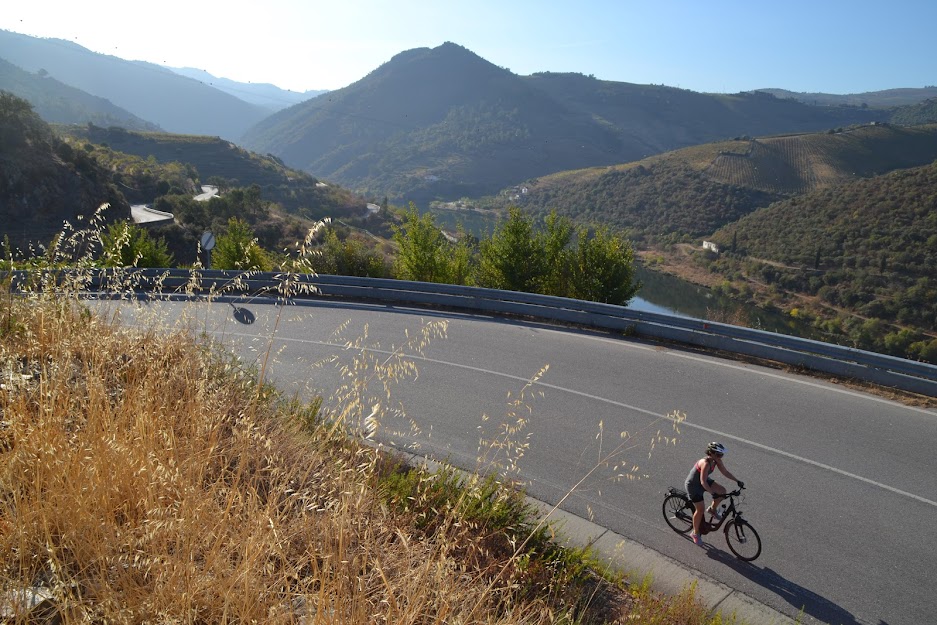
With excellent roads and near zero traffic for the most part, the Douro valley bike route will take you through the most stunning landscapes with breathtaking views of this unique valley. This UNESCO heritage site owes as much to the labors of man in making the remarkable terraced vineyards as with the beauty of the valley itself. A unique micro-climate and varying solar exposure ensure that no two hillsides are alike and the result are the wonderful wines of the region, as well as turn after turn of sublime vistas. The rides are as challenging as they are rewarding, with most climbs being taken on the saddle, as they wind round the contours of the slopes rather than straight up them. Daily average mileage ranges between 35 and 65 km. 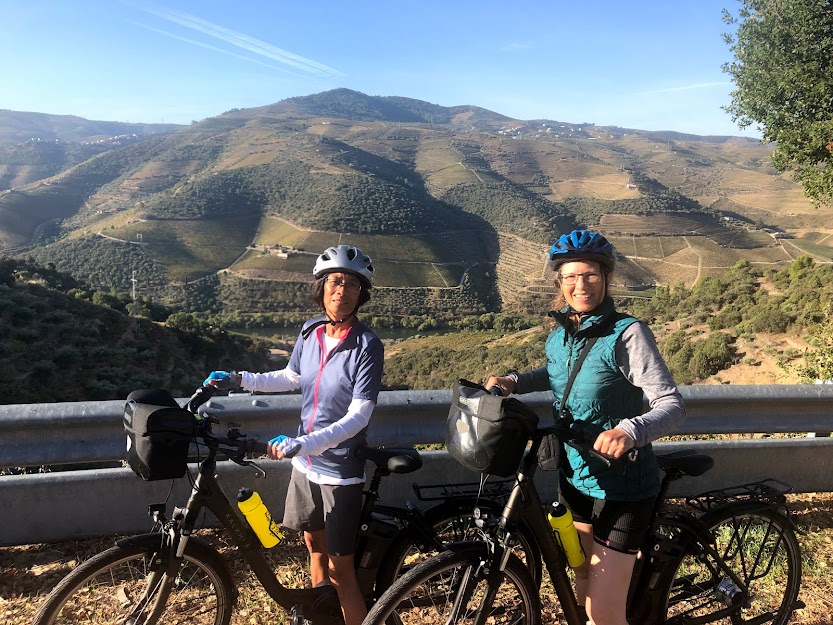
Even so, this is a more challenging route and it's important that you're in good shape to take it on - or you can always consider an ebike to get a little extra help on the hill climbs! Camino Português bike routeThe Camino Portugues cycling route follows one of the official pilgrimage routes to Santiago de Compostella, in the footsteps of the Way of St James. The cycling route follows closely the walking path, along ancient Roman roads of Lusitania and is the second most traveled route after the Camino Frances. 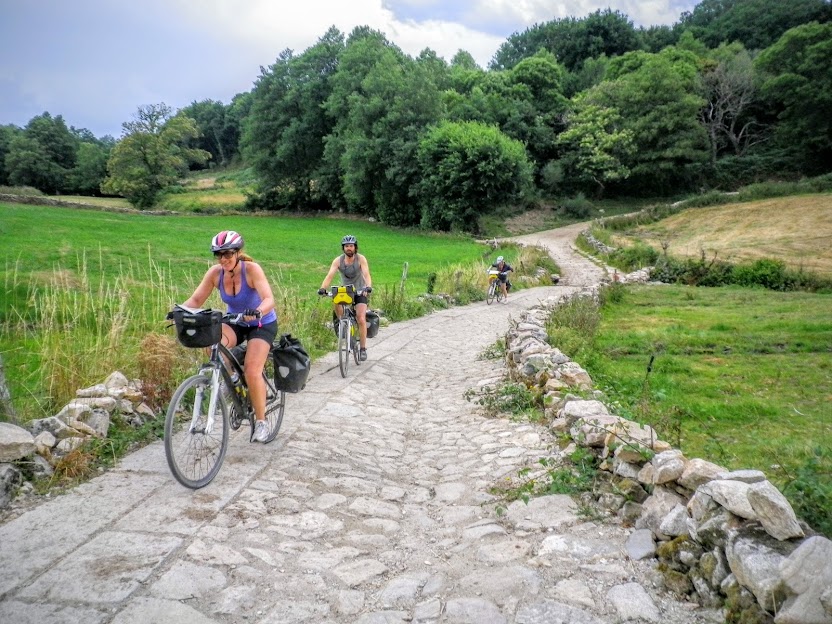
Whichever route you take, the incredible beauty of its varied landscapes, charming villages and monuments to the glory of St James will instill unexpected awe in you. Due to the hilly and mountainous terrain of northern Portugal, this is a more challenging route, so you need to be in good shape to undertake this adventurous bike tour. Expect to ride between 35 and 65 km per day. As mentioned above, don't be put off considering the Camino Portugues, as an ebike can certainly help on the hills and make this route accessible to more riders!
The Best Bike Touring Routes In Portugal For Beginners
If you are new to bike touring, these routes are the best to start with. They are less difficult than the other routes and still offer beautiful views and an in depth experience of Portugal.
Alentejo wine country bike routeRelaxing, Self Guided bike tour across the rolling fields of the Alentejo in Southern Portugal, cycling past wild flowers, vineyards, ancient castles and cork trees along the way. 
Medieval walled villages, white-washed and trimmed in blue, dot the hilltops while plains of wheat and oats spread out below, freckled with small flocks of sheep and goats grazing under majestic cork trees. With traffic free roads and beautiful landscapes it is no surprise that the Alentejo is one of my very favourite regions in Portugal. This is an easy to moderate route with a daily average mileage of between 40 and 70 km on mostly rolling terrain.
Algarve interior bike routeThe Algarve is famous for it's sunshine and sparkling beaches, but the often overlooked interior offers rustic tranquility and outstanding cycling on very low traffic roads. 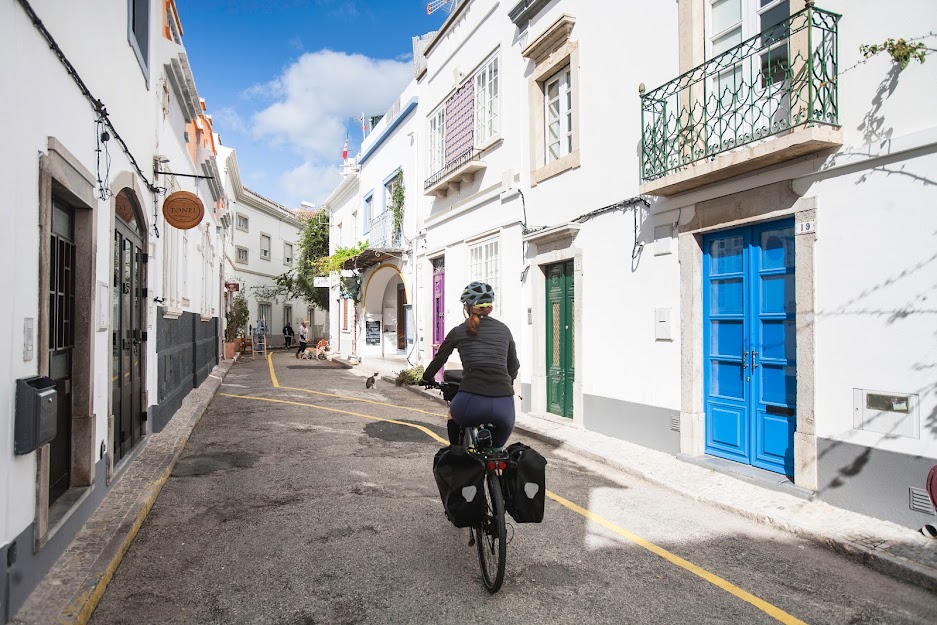
Departing from Tavira, not far from the Spanish border and cycling to Lagos, near the south-westernmost point of Portugal, the Algarve route follows little traveled inland country roads, passing fragrant orange groves and fields of fig, almond and carob as we cycle back to the sparkling beaches the Algarve famous for. This part of Southern Portugal gets around 300 days of sunshine a year and offers some of the finest cycling conditions in Europe. The cycling is easy to moderate with a daily average of between 40 and 60 km. This warm, sunny bike tour route offers great rides, the unbeatable Portuguese hospitality, superb food (particularly fresh grilled fish!) beautiful beaches and plenty of reasonably priced accommodation. If you are looking for a fun and easy bike tour, this is a great choice!
Conclusion: My Favourite Cycling Routes In Portugal
The popularity of cycling in Portugal is on the rise, and with good reason. The country has some of the most beautiful routes for cyclists, with scenery that ranges from iconic coastal routes to picturesque mountains. Whether you're a novice cyclist or an expert, Portugal has the perfect cycling routes for you. My personal favourite bike touring routes in Portugal include the Rota Vicentina, for it's perfect blend of seascapes and bucolic landscapes, as well as the daily option to wet your feet in the Atlantic - before or after a delicious seafood meal. I can never tire of this route! Another personal favourite is the Camino Portugues, although it's not exclusively in Portugal, it covers some of my favourite regions in northern Portugal; the Minho and the Douro. This is where you experience some of the warmest hospitality I've encountered in my travels and the cherry on top is arriving in Santiago de Compostella - always a jubilant triumph, no matter the weather! While the previous two favourites tick all the boxes for an inspiring and exciting bike tour adventure, perhaps my very favouirte cycling route in Portugal remains the Alentejo wine country, for it's very simplicity and tranquility in our hectic times. For someone who loves wine and food as much as they love cycling, the Alentejo is hard to beat - anywhere in the world. It's also a perfect place to unplug, unwind and get far from the crowds. How about you? Have you cycled in Portugal, and if so what is your favourite cycling route or region? You can share your bike touring stories or submit your photos and videos with like minded cyclists right here! |
Cycling In Portugal |
Cycling In Spain |
Bikes & Equipment |
Follow UsFollow us on social media where we share all our special offers, news, events & more.
|
CONTACT Us |
Terms & Conditions | Privacy Policy | Travel Agents | Press Kit | Travel Insurance © Cycling Rentals 2022
Cycling-Rentals is a division of Cycling through the Centuries. Registered Tour Operator RNAAT nº58/2006. Registered Travel Agent RNAVT nº 5035
Cycling-Rentals is a division of Cycling through the Centuries. Registered Tour Operator RNAAT nº58/2006. Registered Travel Agent RNAVT nº 5035

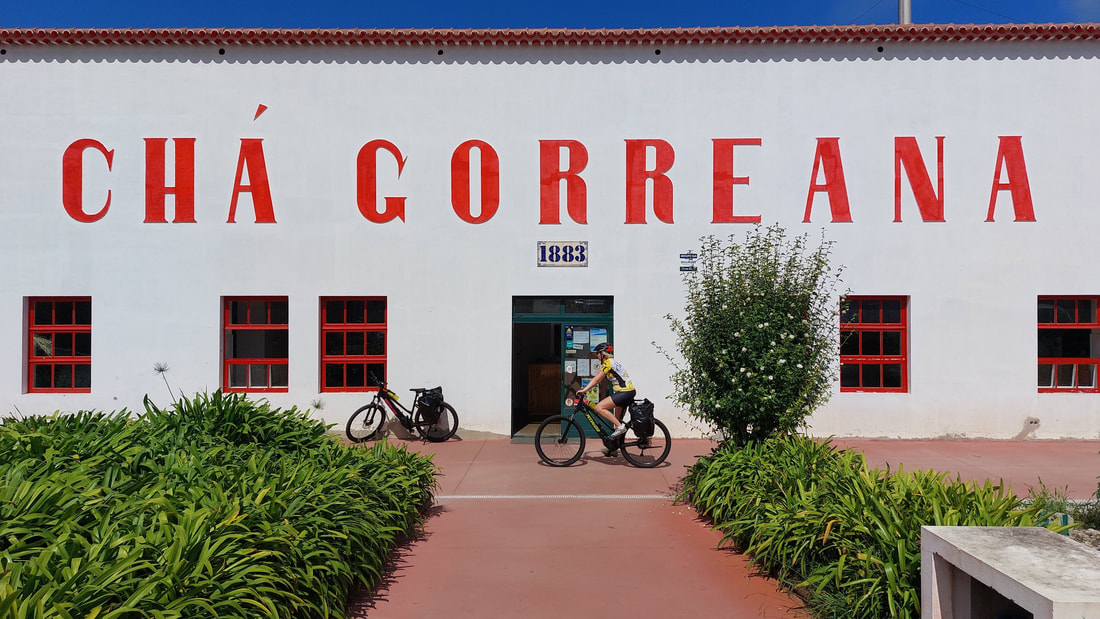
 RSS Feed
RSS Feed





